Aztec Warrior Art
Aztec warrior art was more than just pretty pictures on shields. Feathered suits, stone carvings, painted books... it was a language of power, religion, and survival. To the Aztecs, this art literally helped keep the universe from falling apart.
The Warrior’s Cosmic Job
The Aztecs believed their universe was... fragile. They were living in the "Age of the Fifth Sun," the last era before everything was supposed to end. Their worldview was based on a force called teotl , a constant cycle of opposites, life and death, light and darkness, order and chaos.
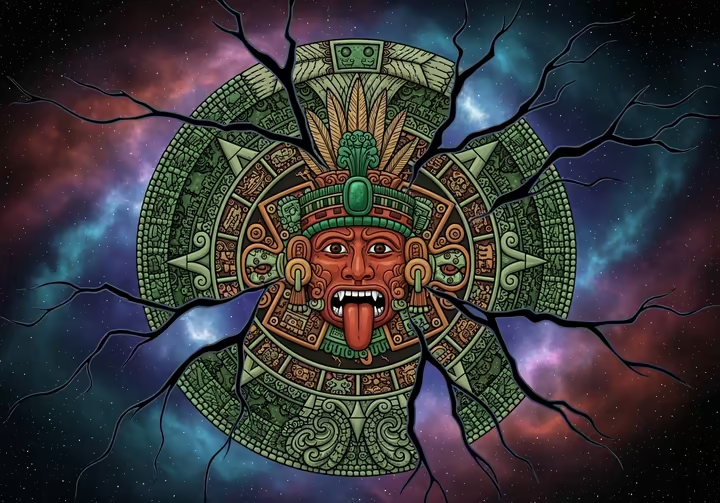
Their myths said the gods had sacrificed themselves to get the sun moving and create people. This act created a huge, endless debt. Human sacrifice was a "debt-payment," or nextlahualli , a duty to feed the gods and stop the world from ending.
Huitzilopochtli, the Sun God
The main god was Huitzilopochtli, god of the sun and war. His origin story is a classic warrior tale. His mother, the earth goddess Coatlicue, became pregnant from a ball of feathers she found.
Her other kids, her daughter Coyolxauhqui (the moon) and 400 sons (the stars), were furious about the weird pregnancy and planned to kill their mom. Just as they attacked, Huitzilopochtli burst from the womb, fully grown and armed with a "Fire Serpent" or Xiuhcoatl .
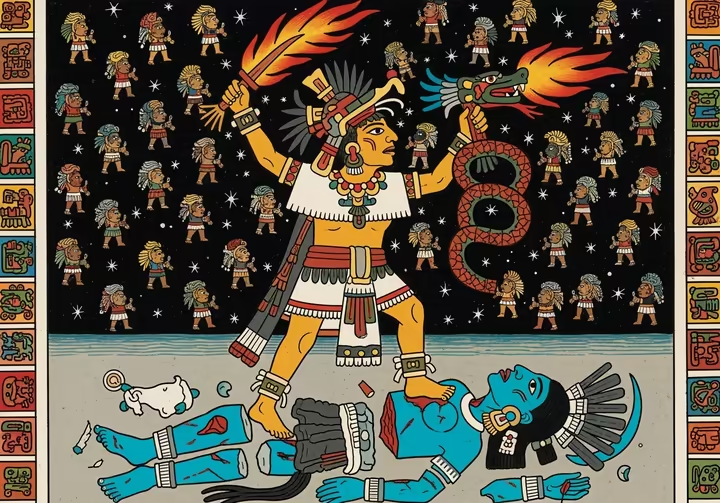
He chopped up his sister Coyolxauhqui and scattered his brothers across the sky. This myth explained the daily win of the sun (Huitzilopochtli) over the night (the moon and stars). But this cosmic fight was tiring, and Huitzilopochtli needed daily fuel, tlaxcaltiliztli , in the form of human blood and hearts to keep going.
A Warrior's Duty
So, the Aztec warrior's main job was getting this god-food. They did this through wars and through ritual battles called xochiyaoyotl , or "Flower Wars."
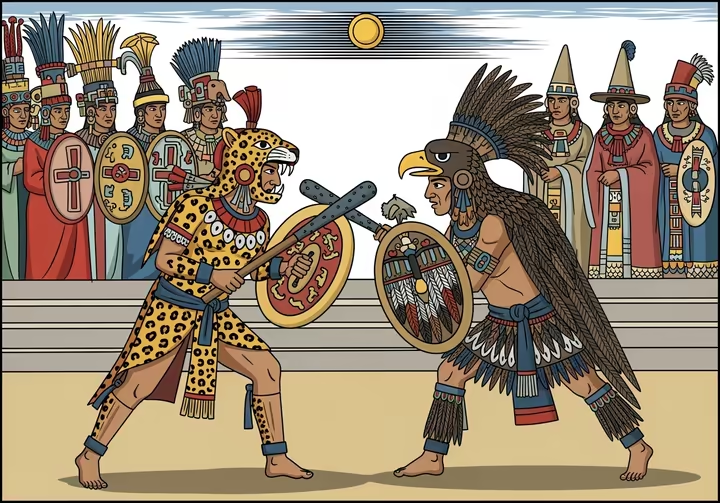
These weren't fights for land. They were pre-arranged battles with rival cities, with the specific goal of capturing enemy warriors for sacrifice. The "Flower War" was a sacred show, and the warrior's art was the costume for this vital performance.
Where to Find Warrior Art
You could find warrior art everywhere, from personal books to giant temples. It was a visual language that reinforced the warrior's importance on the battlefield, in the temple, and at home.
Painted Books (Codices)
The most detailed pictures of warriors come from painted books, or codices, made by skilled artists called tlacuilos . They drew flat figures with strong outlines and bright, symbolic colors. These books are our main visual guide for understanding the Aztec warrior.
The Codex Mendoza , for example, is like a military career guide. It shows the specific warrior costumes ( tlahuiztli ) and weapons a warrior earned based on how many enemies he captured. The Florentine Codex is another key source, a massive encyclopedia with thousands of images of warriors, their gear, and battle scenes.
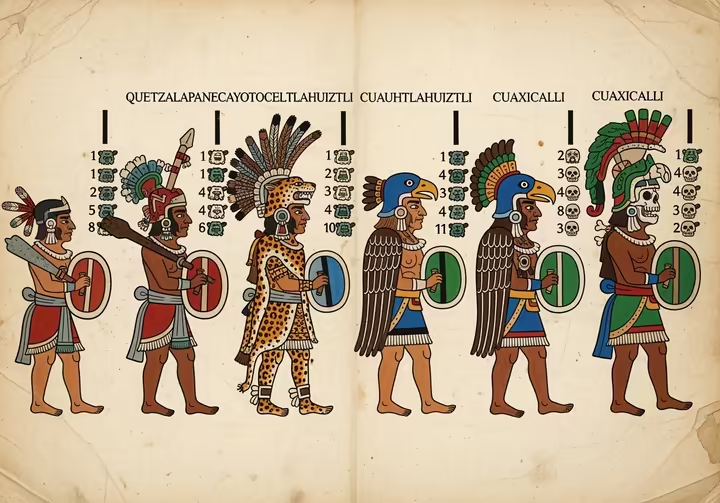
Stone Carvings
Warrior art was also carved in stone for all to see. In Tenochtitlan, the House of the Eagles was a clubhouse for the elite Eagle and Jaguar warriors. Its stone benches were carved with warriors marching to perform acts of self-sacrifice.
The most famous sculpture is the massive Coyolxauhqui stone. This huge, circular stone shows the dismembered moon goddess, her limbs scattered about. It sat at the bottom of the Templo Mayor, the great temple pyramid for Huitzilopochtli.
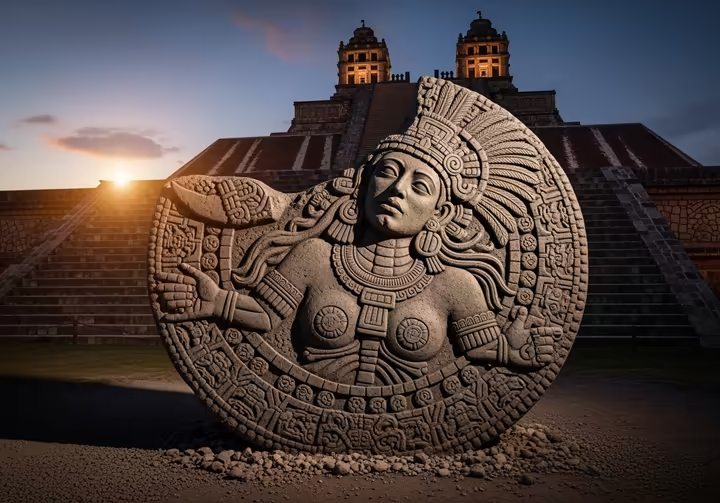
This placement turned the whole pyramid into a symbolic Serpent Mountain. When the bodies of sacrificial victims were rolled down the temple stairs, they landed on the stone, re-enacting Huitzilopochtli's victory over his sister. The temple was a stage for their cosmic story and a scary warning to rivals.
Pottery and Bling
Warrior images also popped up on smaller stuff, like pottery. Polychrome pottery, especially the popular Mixteca-Puebla style, often had symbols like hearts and sacrificial knives. It brought the drama of war to the dinner table.
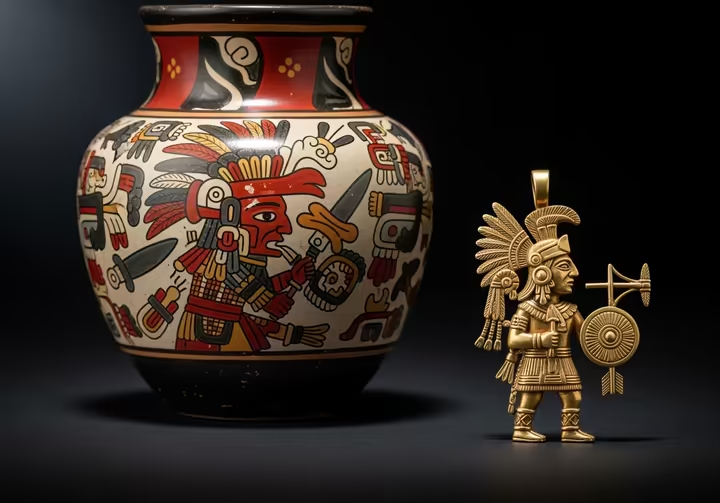
The rich could also get miniature warrior art. A small golden pendant of a warrior holding a shield let a high-status person carry a personal symbol of the empire's power.
A Warrior's Gear
An Aztec warrior's gear was wearable art, and every piece had a job. Dressing for battle meant wearing your resume. The goal was to be seen, understood, and feared.
Armor and Outfits
The basic armor was the ichcahuipilli , a quilted armor made of cotton soaked in saltwater. It was light, practical, and so good at stopping arrows that many Spanish conquistadors wore it instead of their own heavy steel armor.
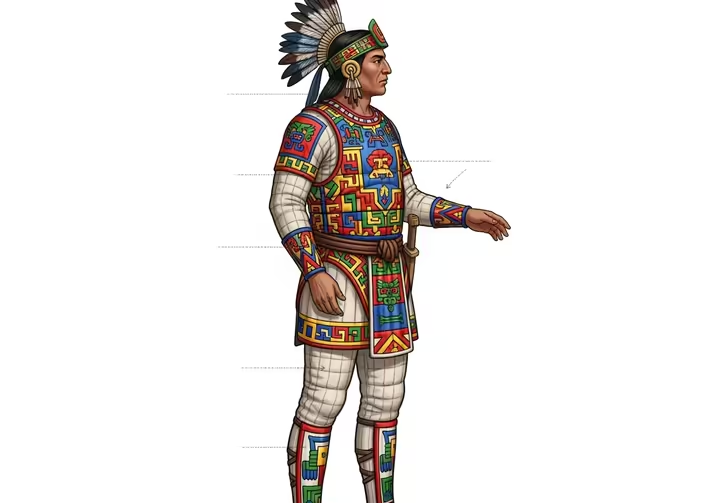
Over this, an elite warrior wore the tlahuiztli , a spectacular bodysuit. These suits were status symbols. Their colors and patterns showed a warrior's rank, a warrior who captured two enemies earned a black-and-red suit, while the top warriors wore brilliant yellow.
Shields (Chimalli)
The shield, or chimalli , was a masterpiece. It was a canvas for the amanteca , the guild of featherworkers. They created stunning mosaics, basically "painting" with the shiny feathers of birds like the scarlet macaw.
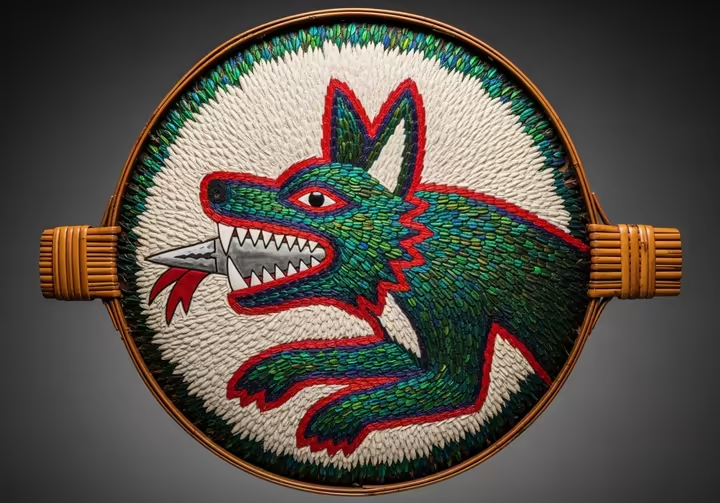
The designs showed a warrior's identity, his family, city, or a specific heroic act. A shield was a billboard you carried into battle. One surviving shield even shows a coyote with a knife for a tongue, spitting out the symbol for sacred war.
Headdresses
The best part of the warrior's outfit was the feather headdress. The most valuable feathers were the long, green tail feathers of the Resplendent Quetzal, worth more than gold. These were only for emperors and top commanders.
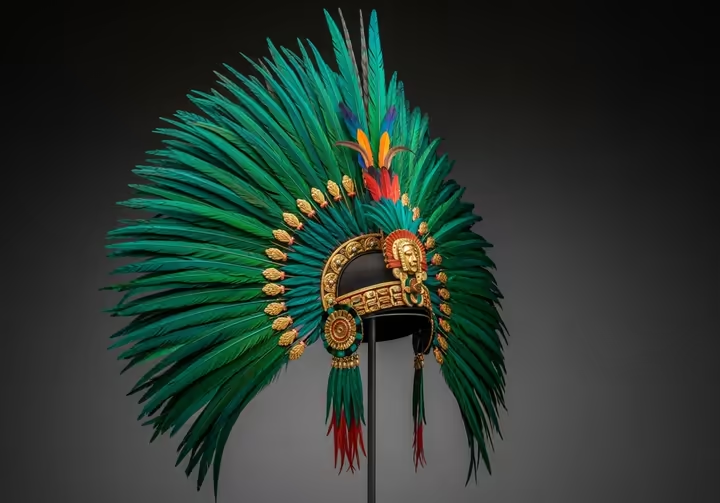
The 'Sword' (Macuahuitl)
Their main weapon, the macuahuitl , was a piece of terrifying art. It was a heavy wooden paddle, not a sword, with rows of razor-sharp obsidian (volcanic glass) blades set into the edges.
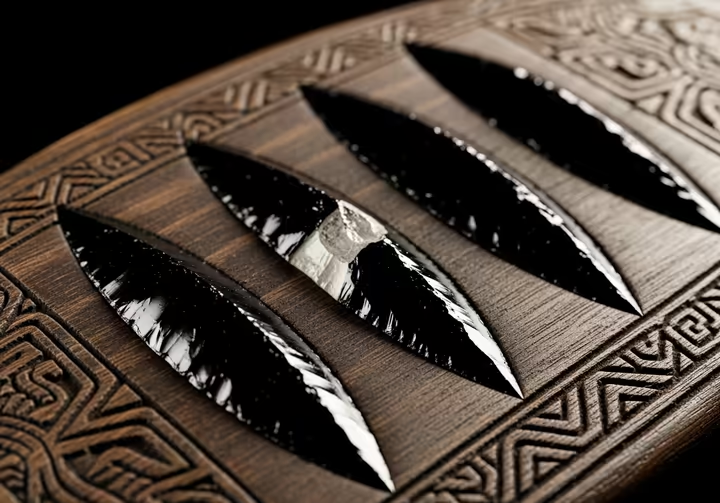
The result was a brutal weapon, able to cause horrible wounds and supposedly cut off a horse's head. The careful craftsmanship and scary power of the macuahuitl made it a perfect symbol of a warrior's deadly skill.
The Big Leagues: Jaguar and Eagle Warriors
At the top of the military food chain were the Jaguar and Eagle warriors. These two groups were living symbols of cosmic balance. Their amazing outfits were a statement about how the universe worked.
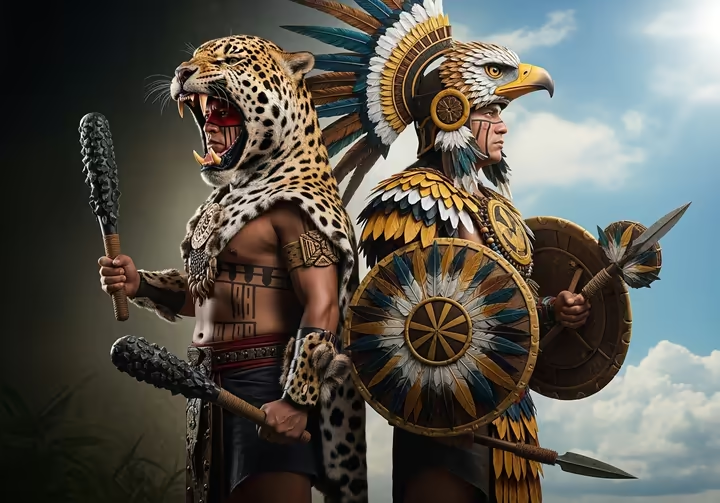
Jaguar Warriors
The Jaguar warriors, or ocēlōpilli , represented the night, the earth, and the powerful god Tezcatlipoca. They are easy to spot in Aztec art. They wore suits made from jaguar pelts, with a helmet shaped from the animal's head, the warrior's face peered out from the jaguar's open jaws.
By wearing the jaguar's skin, the warrior was thought to absorb the animal's stealth and power. He became a human home for the spirit of the jungle's top predator.
Eagle Warriors
The opposite of the Jaguars were the Eagle warriors, the cuāuhpilli . They represented the power of the sun, the sky, and the patron god Huitzilopochtli. They wore feathered bodysuits and helmets shaped like an eagle's head, with a sharp, open beak.
The eagle was the animal form of Huitzilopochtli. Warriors who died in battle were called the quauhteca , "the eagle's people." Their feathered gear turned them into soldiers of the sun.
Cosmic Balance
Together, these two groups represented a key Aztec idea, a duality seen in the phrase in cuāuhtli, in ocēlōtl , "the eagle, the jaguar." This became a shorthand for the perfect warrior. The eagle stood for the sun and the heavens, while the jaguar stood for the night and the earth, a perfect balance.
The Afterlife of Warrior Art
The Spanish conquest in 1521 was a disaster for the Aztec world, and the creation of traditional warrior art stopped. But in a weird twist, the same people who tried to erase the culture ended up helping to save it.
Saved by the Enemy
This was an accident. A friar, Bernardino de Sahagún, wanted to understand native beliefs so he could convert people more easily. He worked with a team of Nahua elders and artists to create a massive, twelve-book encyclopedia of Aztec life.

This masterpiece, the Florentine Codex , is now our single best source on their culture. It recorded the world of the warrior in amazing detail. It saved the visual record of the very traditions the Spanish wanted to destroy.
A National Symbol
For centuries, this art was hidden away in libraries. But in the 20th century, as Mexico created a new national identity, the Eagle and Jaguar warriors were brought back. They became powerful symbols of a glorious, pre-colonial past.

Artists like Jesús Helguera painted heroic images of Aztec warriors. These were mass-produced on calendars and posters. The warrior became a key part of modern Mexican and Chicano visual culture.
From Temples to Tattoos
Today, Aztec warrior art continues to evolve. The old drawings from the codices inspire muralists, video game designers, and artists. But its most personal legacy might be in tattoo art.
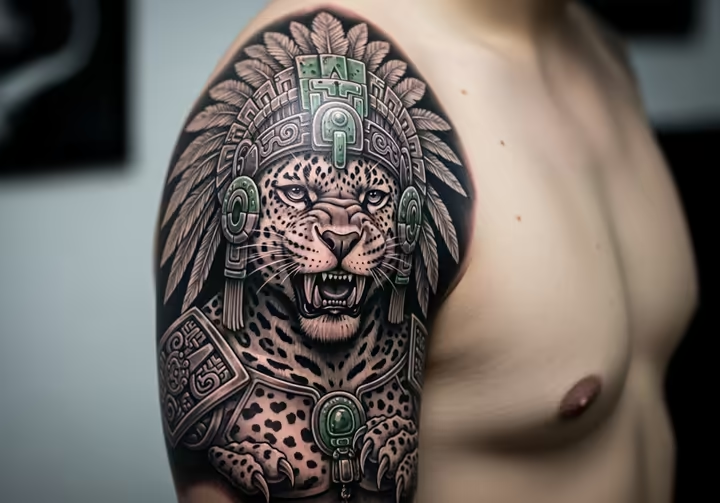
For many people, getting an Eagle or Jaguar warrior tattoo is a way to connect with their heritage. It expresses cultural pride, strength, and courage. What was once art for the gods is now a modern symbol of identity.